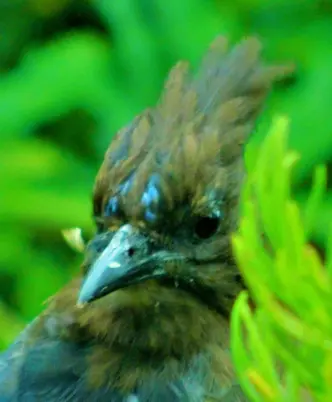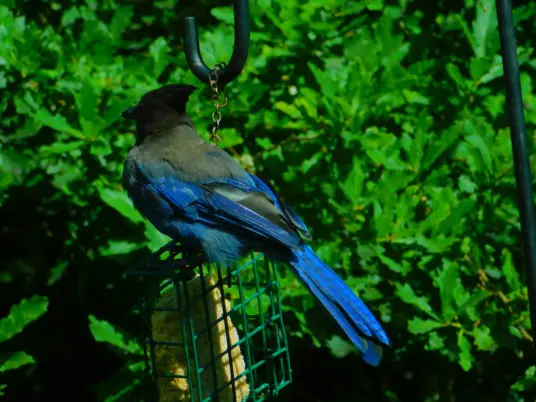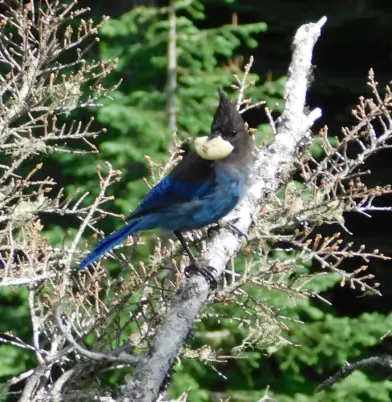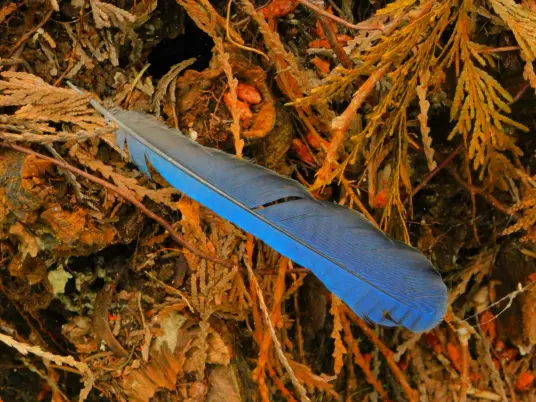Skaykay: A Native Bird on Campus

by Marcia Wilson
A beautiful blue bird is about to come into its own name in 2024. A familiar sight in for the state, its indigo feathers flash in the trees behind the LRC, or the water garden in front of 19. In the Outdoor Lab it thrives, scolding the students and volunteers with a brash SKAYY KAYY scream. Not surprisingly, in the local Lushootseed language the little explorer’s name is skaykay. Meet the Cyanocitta stelleri, Steller’s Jay. As the year of 2023 draws to a close, so does the use of this name.
To what, is unknown, but there will be no more of Steller in it.
Why Steller’s Jay?
The little jay already had a name, the Kakay, by the native Intelmen-language speakers of the Kamchatka Peninsula. Like the Lushootseed name, it was a descriptive. Then, in 1788, a German naturalist working for the Russian Expansion “discovered” it and after his death the bird and about 11 other things were named in his honor. This was not unusual. Quoting BIRD NAMES FOR BIRDS, this created “verbal statues,” and it was problematic to say the least:
Eponyms (a person after whom a discovery, invention, place, etc., is named or thought to be named) and honorific common bird names (a name given to something in honor of a person) are problematic because they perpetuate colonialism and the racism associated with it. The names that these birds currently have… represent and remember people (mainly white men) who often have objectively horrible pasts and do not uphold the morals and standards the bird community should memorialize.
Who Was Georg Steller?

Georg was, to put it politely, a self-promoting go-getter for scientific achievement. Natural science was going through a lot of change in the 18th century and it was all to support expansion Naming species was part of the game.
Steller namesakes:
- Steller’s eider
- Steller’s jay
- Steller’s sea eagle
- Steller’s sea lion
- The Sea Otter
- The mineral Stellerite
- Gumboot chiton
- The flowering plant genus, Stellera
- Hoary mugwort
- Steller’s sea cow
- Steller’s sculpin
- Short-tailed albatross
“Names have power and power can be for the good or it can be for the bad. We want these names to be powerful in a really good way.”— Colleen Handel, the American Ornithological Society president and a research wildlife biologist, U.S. Geological Survey in Alaska.

Steller was in many ways… stellar. He ruffled the feathers of pompous scientists because he pared his travel expenses down to the bone. It was considered proper for his peers to insist on extravagant comforts, such as rich food, wine, waitstaff, and even furniture! Extravagance was a large reason for the high price in scientific expeditions, and this influenced sponsors on their decision to support these trips. Steller didn’t want an inflated standard of living to get in the way of a budget approval. He literally changed the game when he drank beer and water with the same cup.
In an era where expansionism was considered right and just, he was branded a troublemaker for living among and with the Native peoples. He hunted, fished, learned their language and started up a school. Because he paid attention and listened to them, he became the first ship’s doctor to correctly treat scurvy. His anger at their mistreatment by the settlers led to accusations of ‘fostering rebellion’ and he died well before his 38th birthday in 1746, worn out by frequent trips to court to fight these charges. He left behind a staggering amount of research, a higher standard of scientific pursuit, and many admirers; which is why so many things are named after him. The Steller’s Jay was officially dubbed in 1788.
Less than Stellar
Good intentions or no, Steller’s solution to the mistreatment of Kamchatka’s Indigenous peoples was to bring in missionaries, and the school was central to the invaders’ cultural mores that still enforced colonialism and its resultant damage. Today, fewer than 100 living Indigenous people still speak the Intelmen language. Steller’s bias when he writes of Alaskan animals is cringeworthy: he describes sea cows as “greedy” and implied it was their own fault they were so easily killed by hunters.
Steller’s work encouraged and then hastened the nearly-fatal exploitation of the fur-bearing sea otter , plus the extinctions of a cormorant and the already-rare Steller’s sea cow, a cold-water dugong. Its loss meant a lessened biodiversity in the kelp forests and damage to the ecosystems.
“Steller may have been their discoverer, but he was also the harbinger of their end.”—Alex Holt
For the Love of the Bird
Most of the creatures on Steller’s name-list are extinct or struggling. Happily, the little jay is one of the few Steller-attached species still alive and thriving.
While the new names have yet to be determined, what is known is this: names will be not based on a person, living, dead, or imaginary. The name will show what the bird is. In the Steller’s Jay’s case, perhaps its new moniker will honor its unique crest, colors, or a key behavior. There is much that makes them distinctive: they are adaptable and sociable; they travel in groups called a band, a scold, or a party. They thrive from Alaska to Nicaragua; they build mud nests and form long-lasting pair bonds. Their calls imitate other birds, animals, and even machi

nes. This skill may be why our word cajole comes from an old French word for “chatter like a jay”.
The “jay” is likely to stay in the name. The noun dates back to the 3-6th centuries CE and is supposed to evoke the harsh call of the bird. Remarkably, despite its discordant voice, it is classified as a songbird.
So what’s in a name? That which we call a jay, by any other name will sound just as sweet.